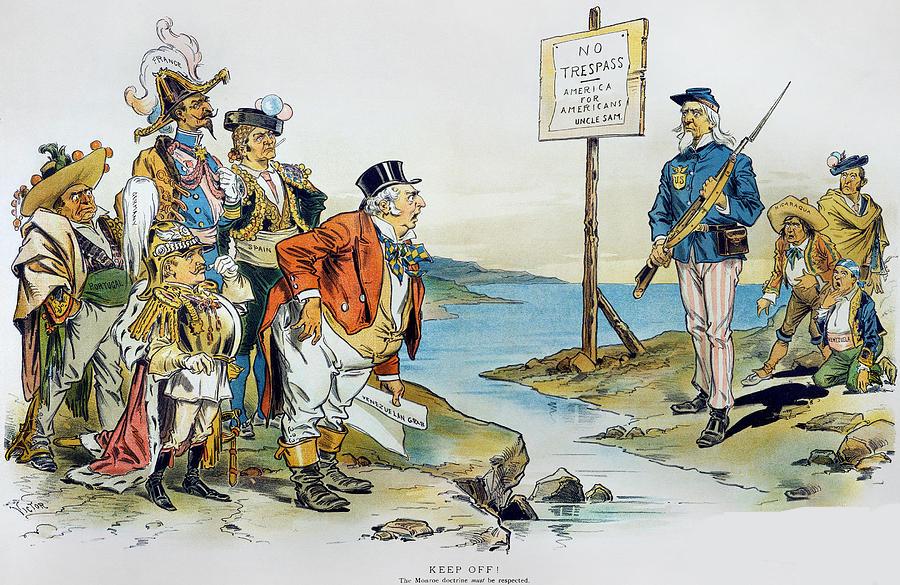What is the Monroe Doctrine?
Today, we’re going to talk about the Monroe Doctrine. What is the Monroe Doctrine, you ask? You’ve probably heard about it in your AP® US History courses or read about it in a textbook, as it is one of the most important pieces of US foreign policy to have ever been created. If you keep reading, by the end of this article you will understand what the Monroe Doctrine was, the historical context of the Monroe Doctrine, and what you need to know about the Monroe Doctrine for the AP® US History exam.
Are you ready? Let’s get started!
Why Do I Need to Know What the Monroe Doctrine is?
The Monroe Doctrine was a part of the US foreign policy created in 1823 during the presidency of James Monroe. The specifics of James Monroe’s presidency are not vital to your success on the AP® US History exam, but the main ideas surrounding the Monroe Doctrine, one of the main accomplishments of his presidency, is very important to understand. This declaration changed the world’s perception of the US at the time, and ultimately shaped the history of the foreign policy for countries that stood as world powers, even though it did not gain much publicity when it was first put into place.
OK, So How Did the Monroe Doctrine Come to Be?
After the French Revolution, most of Europe was in a state of political disarray and distress. Many countries were battling civil rebellions that aimed to overthrow the ruling monarchies, following the examples that had been set by the French. From 1814 to 1815, rulers from several different European countries met at a political gathering called the Congress of Vienna. An Austrian statesman named Klemens von Metternich led the Congress of Vienna, and the goal of the congress was to devise a plan to settle the regional disputes that had developed as a consequence of French Revolution and the Napoleonic Wars. In the end, the attending monarchs agreed to do everything in their power to prevent themselves from being dethroned by democratic movements.
An alliance called the Holy Alliance was formed between France, Russia, Austria, and Prussia at the Congress of Vienna. The goal of this alliance was to allow royal power to be restored in countries experiencing civil rebellions. The Holy Alliance began to restore royal power in 1821, when they defeated liberal rebels in Italy. A few years later, at the Congress of Verona, the Holy Alliance decided to assist the Spanish monarchy in its efforts to maintain the throne. In 1823, the Spanish king returned to the throne, and the Holy Alliance set their eyes on restoring the Spanish monarchy in revolting colonies in South America.
This last pursuit was an unfortunate turn of events for Great Britain, who had benefited greatly from the revolts in South America. Great Britain had been making huge profits as a result of setting up commerce in the Spanish colonies, and the return of Spanish reign would put an end to that.
Wait, Isn’t This the AP® United States History Exam?
You may have noticed that, so far, we haven’t said anything about the United States. During this time, the United States had adopted a policy of isolationism in order to prevent ourselves from engaging in wars that we were not prepared to handle as a fledgling country. Don’t worry; we’re getting there!
Afraid that the Spanish throne and the absolute power that came with it would be restored in South America, George Canning, the British foreign minister, sought out to bargain with the United States. Canning proposed that Britain and the United States could form an alliance against the French and anyone else trying to restore power to Spain. One condition of this alliance, however, was that the United States had to abandon any plans to conquering any territory in South America.
Upon hearing this plan, John Quincy Adams, the Secretary of State at the time, was not entirely satisfied with the terms of this alliance. Adams was honored that Britain, a country that the United States had recently gone to war with in order to secure our independence from colonial rule, would be interested in forming a mutually beneficial alliance. However, Adams did not agree with the United States being forced to renounce all intentions of ever colonizing South America, as he feared that allowing European powers to colonize South America might lead to a return of British rule in North America. Adams also felt that all countries involved in the Holy Alliance should be informed of the intentions of Great Britain and the United States before this alliance could be formed. He felt that it was more dignified and proper to state their aims to protect the Spanish colonies clearly to their opponents.
Adams spoke with President Monroe about this ordeal promptly. Monroe agreed with the Adams’ concerns, and together they created the declaration that came to be known as the Monroe Doctrine.
What Was the Monroe Doctrine?

The Monroe Doctrine was one of the first pieces of US foreign policy that established the United States as a powerful country. It was first introduced in an address to Congress in 1823 by President Monroe. While the Monroe Doctrine would go on to have significant consequences on US foreign policy in the future, the doctrine itself was quite simple, and was composed of two main points:
The Two Main Points of the Monroe Doctrine for APUSH
1. It was proclaimed that the colonization of North and South America by European powers was prohibited from that point forward. Monroe suggested that any attempts to colonize in the Americas would be viewed as a threat directly aimed at the United States, and that the United States would defend against those threats accordingly.
2. The United States would avoid any participation in European affairs. This included meddling with existing colonies in North and South America belonging to European countries.
How Was the US Going to Enforce the Monroe Doctrine?
Interestingly enough, the United States had virtually no way of backing up the statements we made in the Monroe Doctrine. In effect, the declaration was one huge, but empty,threat. However, the threat proved to be effective, as no European country made any move to colonize the Americas following the declaration of the Monroe Doctrine. Following the declaration, the United States joined into an alliance with Great Britain. This alliance granted the nation access to Britain’s Royal Navy, which was the most prevailing fleet in the world at that time. In all likelihood, the threat of the British Royal Navy was more than enough persuasion for other European countries to abide by the conditions of the Monroe Doctrine.
So What Do I need to Know About the Monroe Doctrine to Ace the AP® US History Exam?
So how do we apply this to the AP® US History exam? The Monroe Doctrine was an important part of the United States’ journey to becoming the world power that it is today, and therefore is a topic often seen in both multiple choice and free response questions on the AP® US History exam. Most multiple-choice questions concerning the Monroe Doctrine are trying to test you on the immediate and far-reaching consequences of the Monroe Doctrine for the United States. Let’s work through an example, so that you know how to approach any multiple-choice question concerning the Monroe Doctrine that shows up on the exam.
The Monroe Doctrine had the ultimate effect of:
A) Allowing European powers to colonize South and Central America
B) Strengthening the US Navy by giving the US access to the British Royal Navy
C) Establishing the US as a global power and preventing possible future re-colonization by European forces
D) Restoring the reign of Napoleon Bonaparte
Looking at this question, the first answer that you should be able to rule out is D), as the French Revolution had ended by the time President Monroe declared the Monroe Doctrine and is, therefore, not relevant to this question. From there, A) can be ruled out, as the Monroe Doctrine had the exact opposite effect. This leaves us with B) and C). This may seem tricky, as B) is technically correct, however, it was not the ultimate goal of the Monroe Doctrine. From there, you can figure out that the correct answer is C). By using the process of elimination to determine which answers can’t possibly be correct, you’ve arrived at the correct answer! Alternatively, if you are very familiar with the topic of the question, you could immediately pick out C) as the correct answer based on your knowledge. Both strategies are effective approaches to the APUSH multiple-choice section.
When it comes to the free response section of the AP® US History exam, the Monroe Doctrine can often be used as an example. For example, in 2013, an essay prompt on the APUSH exam instructed students to analyze the methods that the United States used to progress its foreign affairs up until 1823. This question would be an excellent opportunity to mention the Monroe Doctrine and its effect on US foreign policy in the wake of the Revolutionary War, the War of 1812, the Napoleonic Wars, and the French Revolution. In fact, the scoring guidelines specifically note the importance of the Monroe Doctrine in contributing to the advancement of world affairs during this time in America’s history. Having an understanding of the Monroe Doctrine and its consequences could end up being a central component to a great essay on the AP® US History exam.
You’ve reached the end of this article; congratulations! Be sure to read through some of the other articles on this website in order to further familiarize yourself with the many topics that will show up on the AP® US History exam. In addition, feel free to reach out to us with feedback on this article, interesting study skills that you’ve found to be useful for the APUSH exam, or just to say hi!
Looking for AP® US History practice?
Kickstart your AP® US History prep with Albert. Start your AP® exam prep today.








